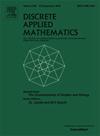Paired-domination in binary trees
IF 1
3区 数学
Q3 MATHEMATICS, APPLIED
引用次数: 0
Abstract
A set of vertices in an isolate-free graph is a paired-dominating set if every vertex of is adjacent to some other vertex in and the subgraph induced by the set contains a perfect matching. The paired-domination number of is the minimum cardinality of a paired-dominating set in . A binary tree is a tree in which every vertex has degree 1 or degree 3. We determine a tight upper bound on the paired-domination number of a binary tree and show that if is a binary tree of order , then . Thereafter we continue the study of a version of the paired-domination game recently introduced by the authors (Gray and Henning, 2023) that embraces both the domination and matching flavor of the game. We give an explicit formula for the game paired-domination number of an infinite family of binary trees and show that if is a binary caterpillar of order , then , where takes on one of the values in the set . We show that if is a complete binary tree of order , then . We conclude with a conjecture that where the supremum is over all binary trees of order .
二叉树中的配对支配
如果无隔离图G的每个顶点与S中的其他顶点相邻,且由该集合S导出的子图G[S]包含完美匹配,则该无隔离图G中的顶点集S是成对支配集。G的配对支配数γpr(G)是G中配对支配集的最小基数。二叉树是每个顶点都有1度或3度的树。我们确定了二叉树成对支配数的紧上界,并证明了如果T是n≥4阶的二叉树,则γpr(T)≤23(n−1)。此后,我们继续研究作者(Gray和Henning, 2023)最近介绍的配对统治游戏版本,该版本包含了游戏的统治和匹配风格。我们给出了无限二叉树族的对策配对支配数的显式公式,并证明了如果T是n阶的二叉树,则γgpr(T)=34n−Φ(n),其中Φ(n)取集合{1,32,2,52}中的一个值。我们证明了如果T是n阶的完全二叉树,则γgpr(T)<(23+1192)n。我们得到了supγgpr(T)n=34的一个猜想,其中在所有n≥4阶的二叉树T上存在最优。
本文章由计算机程序翻译,如有差异,请以英文原文为准。
求助全文
约1分钟内获得全文
求助全文
来源期刊

Discrete Applied Mathematics
数学-应用数学
CiteScore
2.30
自引率
9.10%
发文量
422
审稿时长
4.5 months
期刊介绍:
The aim of Discrete Applied Mathematics is to bring together research papers in different areas of algorithmic and applicable discrete mathematics as well as applications of combinatorial mathematics to informatics and various areas of science and technology. Contributions presented to the journal can be research papers, short notes, surveys, and possibly research problems. The "Communications" section will be devoted to the fastest possible publication of recent research results that are checked and recommended for publication by a member of the Editorial Board. The journal will also publish a limited number of book announcements as well as proceedings of conferences. These proceedings will be fully refereed and adhere to the normal standards of the journal.
Potential authors are advised to view the journal and the open calls-for-papers of special issues before submitting their manuscripts. Only high-quality, original work that is within the scope of the journal or the targeted special issue will be considered.
 求助内容:
求助内容: 应助结果提醒方式:
应助结果提醒方式:


